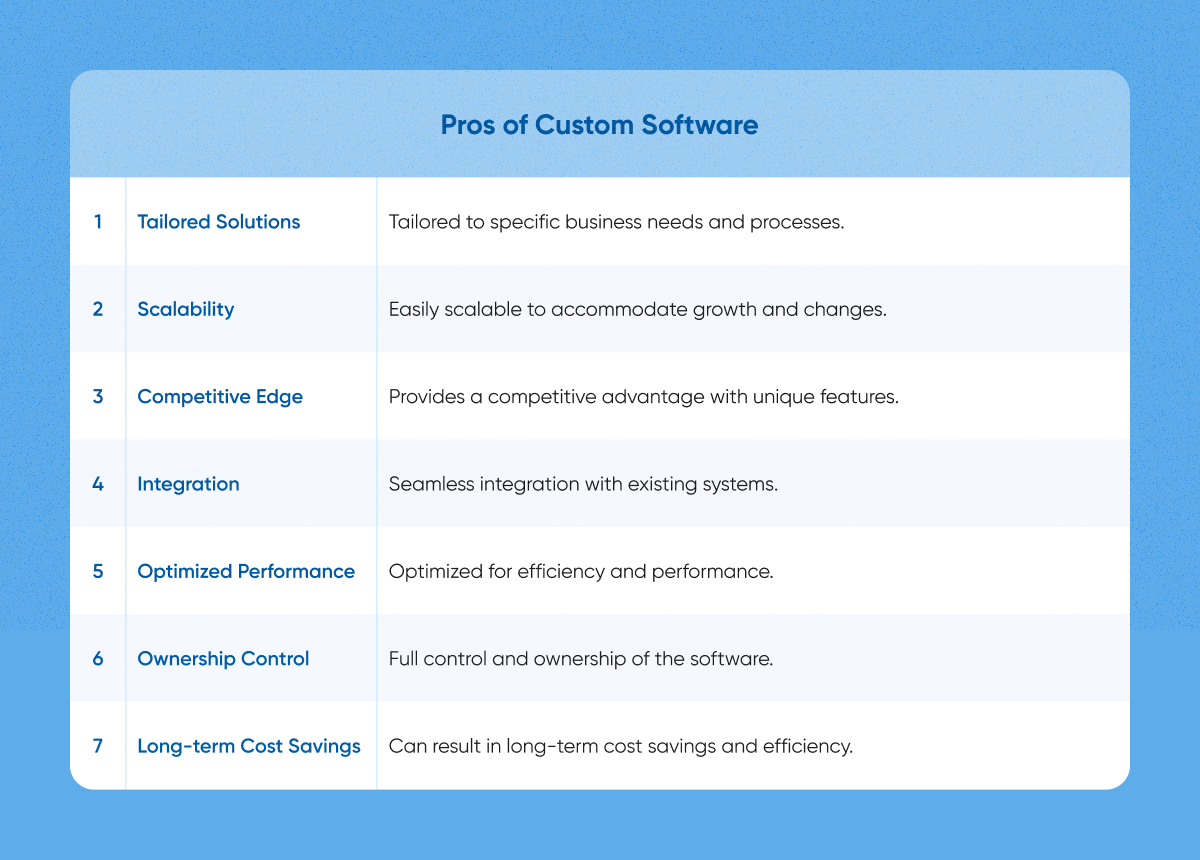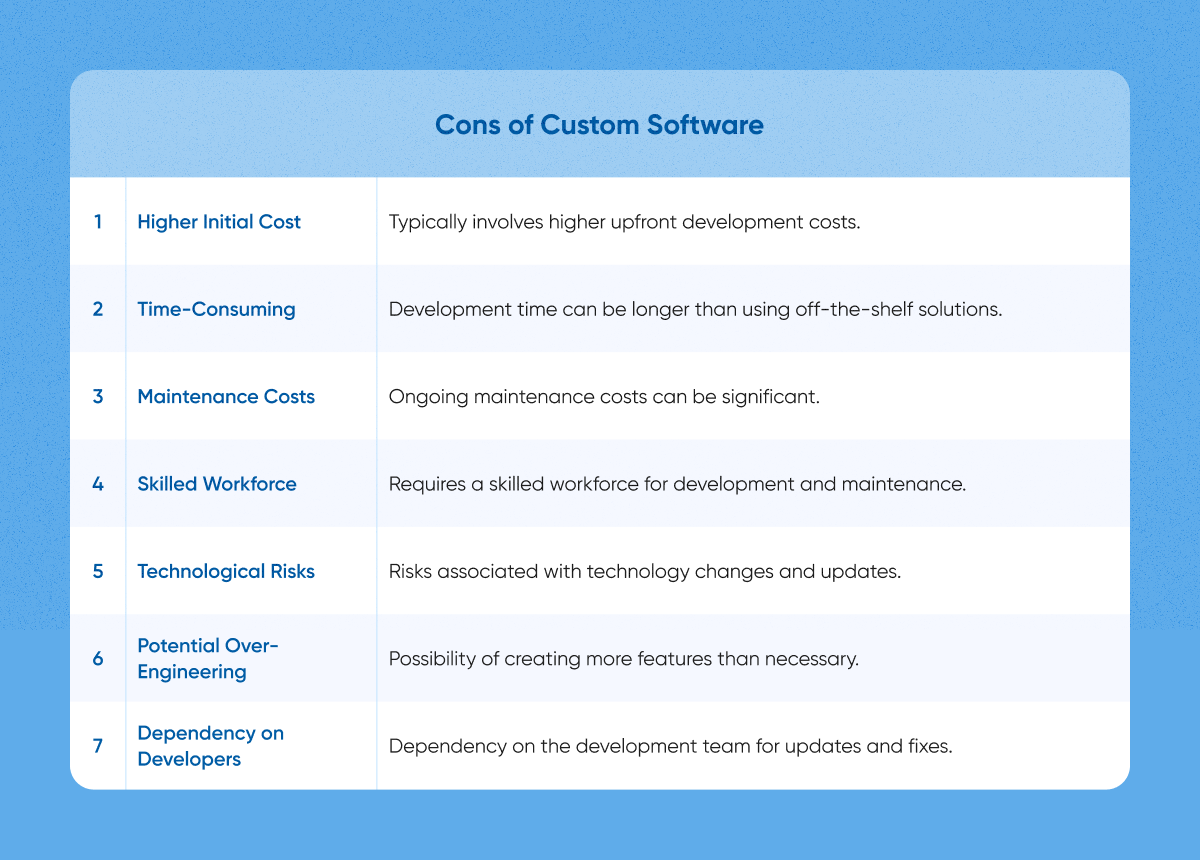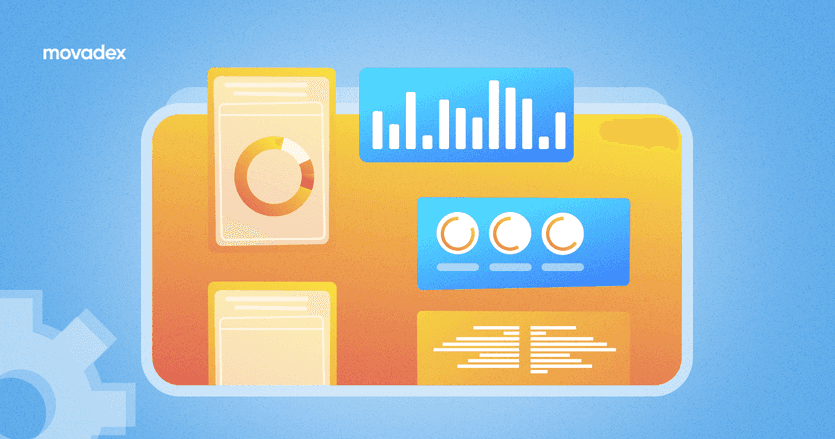Did you know that the small and medium-sized businesses (SMBs) segment is the largest market for custom software development, followed by the large enterprises segment? This market is expected to reach $146.18 billion by 2030, growing at a CAGR of 22.3% from 2022 to 2030 according to Grand View Research.
Forecasts suggest that industries such as Banking, Financial Services, Insurance (BFSI), Government, and Healthcare exhibit and will continue to manifest the most pronounced proclivity for custom software development, particularly within the domains of web and mobile application development.
Given these projections, the imperative question emerges: Does your enterprise necessitate the integration of custom software solutions? Is it worth the money? We analyze further in the article.
What Does Custom Software Development Mean? [+Example]
Custom software development involves the creation of software applications meticulously tailored to the specific needs of individuals, organizations, or businesses. In contrast to off-the-shelf software, which caters to general use and is commercially available from vendors, custom software is developed from the ground up to address the distinct requirements of a particular user or a specific user group.
For example, let’s take a look at SaaS custom software. We had experience working with Zamna — a technology company revolutionizing airport security and passenger verification solutions. They addressed us as they wanted to create a secure and efficient passenger identity verification while complying with travel regulations. We worked closely with Zamna to develop innovative solutions that streamline the verification process, improving operational efficiency for airports and airlines.
Our joint efforts yielded tangible results: a refined and secure flow of trusted identity data throughout the travel ecosystem. This not only ensured compliance with regulations but also contributed to an improved passenger experience. By simplifying the verification process, we helped airports and airlines boost operational efficiency, minimize bottlenecks, and fortify security measures.

That is a solid example that illustrates custom software, just to give you a sense of what it entails.
What Is The Process Involved In Custom Software Development Services
While methodologies may differ across the industry, we prioritize clarity and openness in our approach. Let's take a closer look at our process, tailored to ensure you have a clear understanding of each step.
1. Initial Consultation
A free initial call allows us to comprehend the intricacies of your business and discern whether the solution lies in custom software or a potential redesign. This candid dialogue sets the stage for more comprehensive discussions with our team specialists. Subsequently, a call with our co-founder deepens our understanding of your business, guiding decisions on outsourcing or in-house staffing.
Not sure about the nuances of outsourcing versus outstaffing? Feel free to explore our insights here or let our team elucidate during our initial call.
2. Research and Project Analysis
The next phase involves a thorough examination of your project. Taking a few days, our team delves into extensive research, culminating in a detailed estimate that becomes the foundation for the project's trajectory.
3. Meet & Greet: Getting to Know Us
In a bid to foster a sense of familiarity, we extend the opportunity for you to meet our team. This face-to-face interaction allows you to pose questions and acquaint yourself with the individuals who will be instrumental in shaping your project. Once both parties are aligned, formalizing the partnership with a signed contract marks the official commencement of your project.
4. Requirement Analysis
Early project stages involve a meticulous analysis of design mockups, the establishment of milestones with our Project Manager and CTO, determination of technical architecture, and selection of an appropriate tech stack. This personalized approach ensures that your app not only meets but exceeds market standards.
5. Implementation
As the project gains momentum, our focus shifts to the core components of software development:
- Back-End Development: This constitutes the brain of the software, handling data processing and storage.
- Front-End Development: The user-facing elements that significantly impact user experience and performance.
- API Integration: Serving as the intermediary facilitating seamless communication between different applications.
6. Testing
Ensuring the quality of the developed solution is paramount. This phase involves a comprehensive testing regimen, including integration, unit, system, acceptance, and non-functional testing. Identifying and addressing any issues discovered during testing is crucial, potentially influencing the overall development timeline.
7. Deployment & Launch
After finalizing the product and addressing issues identified during testing, the code is deployed to customers. Beta testing ensures scalability, with any remaining issues promptly handled by our engineering team. Once all is refined and your product is free of bugs, it is ready for its grand launch into the market.
The Pros of Investing in Custom Software
Unlike off-the-shelf solutions that provide static products, incapable of adapting to the evolving needs of a growing business, custom software offers a dynamic alternative. Engineered with flexibility in mind, custom products can accommodate changes and expansions effortlessly. By incorporating adaptable features and expansion-friendly structures, custom software developers have the capability to position your business for sustained success in the future.
1. Reduce security risks
Custom software can be designed with specific security protocols and data encryption measures to protect sensitive information and minimize the risk of security breaches.
2. Tailored Solutions
Custom software is designed specifically to address the unique needs and processes of a business, ensuring that it aligns seamlessly with the company's workflows and objectives. Off-the-shelf software, on the other hand, often requires workarounds and compromises to fit the specific requirements of an organization.
3. Competitive Edge
Custom software can provide a significant competitive advantage by enabling businesses to offer unique features and functionalities that are not available in off-the-shelf solutions. This differentiation can attract new customers, retain existing ones, and strengthen the company's position in the market.
4. Integration
Custom solutions seamlessly integrate with your existing systems. This integration ensures a cohesive and efficient flow of data across different facets of your business operations, eliminating silos and enhancing overall productivity.
5. Ownership Control
Investing in custom software grants the company complete ownership and control of the software code, intellectual property, and any subsequent updates or modifications. This ownership provides businesses with the freedom to adapt the software to their evolving needs and priorities without being constrained by external vendors or licensing agreements.
6. Improve customer satisfaction
Custom software can provide a more personalized and user-friendly experience for customers, leading to increased satisfaction and loyalty.
Also, the customized nature of the software ensures that every feature and functionality contributes directly to your business objectives which leads to greater Return on Investment (ROI).

The Cons of Investing in Custom Software
1. High Upfront Cost
Custom software development requires a significant upfront investment due to the resources required to design, develop, and test the software from scratch. This initial cost can be a barrier for small or medium-sized businesses with limited financial resources.
2. Lengthy Development Time
The development process for custom software can be lengthy and complex, often taking months to complete. This extended timeline can be challenging for businesses that need a solution quickly or are operating under tight deadlines.
3. Potential Over-Engineering
Overengineering, as defined by the source, refers to the tendency to design a product or devise a solution to a problem in an excessively intricate manner. This occurs even when a simpler alternative could be demonstrated to possess equal efficiency and effectiveness compared to the initial design.
In some cases, over-engineering can even make a product or solution worse than if it had not been engineered at all. This is because over-engineered solutions can be more difficult to use, more likely to fail, and more expensive to maintain.

Decision-Making Tips: Do You Need Custom Software or Not?
While you can certainly inquire about the necessity of custom software during our initial call within your budget constraints, we also encourage you to take some time to acquaint yourself with the concept beforehand.
1. Consider your business needs
The most important factor to consider is whether or not your business has specific needs that cannot be met by off-the-shelf software. If your business has unique processes, workflows, or data requirements, then custom software may be the best solution.
- Custom software: Is designed to meet the specific needs of a business, so it can be a good option for businesses with complex or unique requirements.
- Off-the-shelf software: Is designed to be used by a wide range of businesses, so it may not be able to meet the specific needs of a particular business.
2. Assess your budget
Custom software can be expensive to develop, so it is important to make sure that you have the budget for it. If you do not have the budget for custom software, then off-the-shelf software may be a better option.
- Custom software: Can be expensive to develop, but it can also be a good investment in the long run if it helps your business to be more efficient and productive.
- Off-the-shelf software: Is typically less expensive than custom software, but it may not be as well-suited to your business needs.
3. Consider your timeline
How quickly do you need a solution? Custom software can take longer to develop than off-the-shelf software, so if you need a solution quickly, then off-the-shelf software may be a better option.
- Custom software: Can take several months or even years to develop.
- Off-the-shelf software: Can be implemented in a matter of days or weeks.
4. Ask yourself the following questions
- What are my business's specific needs?
- What is my budget for software?
- What resources do I have available?
- How quickly do I need a solution?
- How likely are my business needs to change in the future?
- What are my long-term goals for my business?
By answering these questions, you can start to narrow down your options and make an informed decision about whether or not you need custom software.
Conclusion
The decision to invest in custom software is a strategic one, with both pros and cons to consider. The tailored solutions, scalability, and competitive edge offered by custom software can significantly benefit businesses, but the higher initial costs and potential complexities should not be overlooked. It is crucial to carefully weigh these factors against your specific needs and resources.
As you navigate through this decision-making process, we invite you to explore our solutions for custom software development. Our team at Movadex is dedicated to creating bespoke solutions that align seamlessly with your business objectives. To learn more about how our сustom software services can elevate your operations, feel free to contact us at salome@movadex.com or schedule a complimentary call directly here. We look forward to assisting you on your path to optimized digital solutions tailored to your unique requirements.




